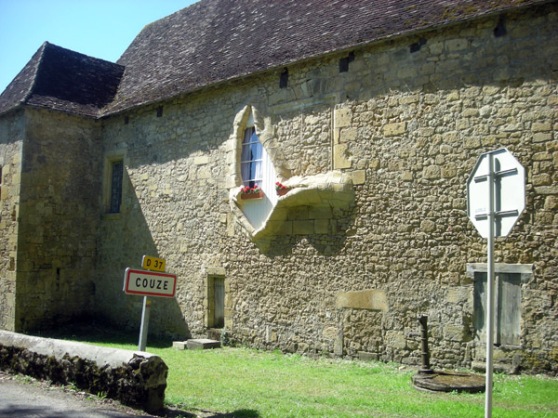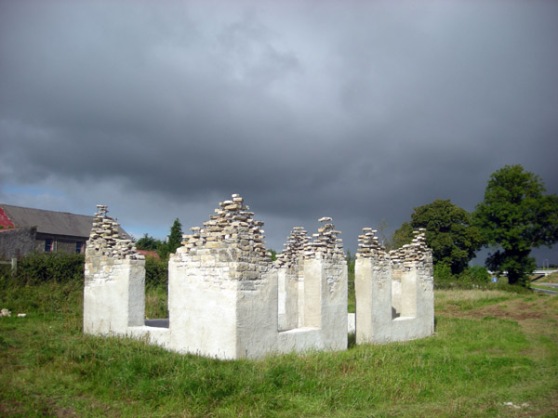Interviewed by Gabriella Alziari
“Once a viewer put it very well: there is a “moment of catastrophe” in my work– but I also hope a moment of humour.”
-Cornelia Konrads
Cornelia Konrads is a German installation artist. She creates site specific installations and objects, exhibiting her permanent and temporary work in private gardens, sculpture parks, and public spaces. She also enjoys participating in a number of Land Art Projects. In the past, Cornelia has exhibited in Germany, the Netherlands, Italy, France, Belgium, Sweden, the United States, Taiwan, South Korea and Australia. Her combination of art, philosophy, and traveling gives her work a unique vibrance that fits well with the settings she chooses.
What was your first introduction to art?
For my parents, giving me a pencil and a piece of paper was the best way to keep me silent in my place… maybe this was my first introduction to art.
Later I frequently visited an art museum close to the town where I grew up; it’s called “Island of Hombroich”. This museum has a special concept that I liked very much: presenting modern occidental art and art from other cultures in a direct dialogue. It was fascinating for me to study the languages of form and colour, the different techniques and materials in this cross-cultural ambience. They also have a big outdoor area where I saw the first land art works and site specific installations.
Tell us about yourself and your work.
I have three passions: art, philosophy and traveling.
Thankfully, life has offered me a way to combine them all, but it took me a while to reach this point. First I worked as a teacher and did my artwork beside the job. I learned printing techniques on my own and worked for a while as an assistant for an elder sculptor, who taught me a lot. I started to exhibit drawings, prints and objects and became increasingly intrigued by site specific installations. It started with small interventions on hiking tours and became more and more important for me. Finally, in 1998, I had a first big outdoor exhibition and received a grant, which encouraged me to quit my job and become a free lanced artist– it was kind of a jump into the cold water, but I never regretted it.
Becoming a member of an international network for site specific art helped me to exchange with other artists, and I received information about land art projects and residencies all over the world. For some I applied, and was quite successful. This ushered a new era of my life: being a traveling artist.
All of my site specific works are preceded– and followed– by a travel. In a certain way the travel is a part of the work: meandering in an unknown territory in search of the site and the form for a planned installation, I collect what lies on the edge of my path– stories, shapes, materials, local habits and occurrences– until I come to a place, where these collected impressions condense into an image.
I understand the site not as a background, but as a texture. The goal is that my work becomes a part of this texture– in the end, it is unclear if it has always been there or if it will change or disappear in the next second.
Philosophy is the art of posing questions. Visual art is also all about posing questions, but beyond the limits of language, so I feel it’s more free.
The questions I put in my work deal a lot with the perception of time and movement– often my installations appear as if a film has stopped for a moment– a moment of “frozen time”.
I’m intrigued by this transient thing, called “moment” or “presence”– the intangible rupture between past and future. Consequently I try to create a moment of irritation, by adding an element to the scenery, which refuses to fit into the expected order. If something doesn’t behave as it should, within the twinkling of an eye the inner monologue gets interrupted. One “arrives here and now”, in a mysterious world, where strange things (including oneself) have a unique meeting. For this moment of irritation I like to challenge what is supposed to be “reliable”: the laws of gravity, the solidity of walls or the ground under our feet. Once a viewer put it very well: there is a “moment of catastrophe” in my work– but I also hope a moment of humour.
What inspires you?
The process of searching and finding “my site” as I described above. Coincidences. Accidental arrangements.
Other inspirations come from the work of Anish Kapoor, Louise Bourgeois, Tadashi Kawamata, Joseph Beuys and Banksy. And I love street art!
I’m also interested in architecture and admire architects like Terunobu Fujimori or Frank Gehry – and the spiders in my studio!
Much of your work is set outdoors and uses natural materials. How did this come about?
I also do indoor works… however, all of the places I work have in common that they are not neutral, not just a background. None of these places really resembles the other– you can’t just put up whatever there, you have to respond to what’s given– this is the challenge.
About materials: I often use materials I find at the site, or connect my work to existing structures. But it’s not at all a dogma for me to work with “natural” materials only. Actually I use all kinds of materials that are suitable and not destructive or harmful for the place. Anyway I doubt that there is a strict limit between “natural” and “artificial”. But this is another subject…
How do you go about constructing your structures? Is it not physically demanding?
Of course it is. But other people do sports, or go to a fitness studio; all those things I don’t need.
In fact I like to move, to feel my physical limits, to get my hands dirty– it keeps me mobile. And if something is really too heavy, I ask for assistance…
Of course for the really big works, for “settlement” for example (realised in Ireland 2010), the organiser provides assistants. In this case it was a team of Irish stone masons who did the basement. These kind of collaborations are also a challenge for me: I meet people who rarely had any contact with art, especially with a woman working in this field. But until now, encounters like these have always been fruitful in the end: I learn from their skills, and they learn that there are different ways of perception.
What has one of your favorite pieces or projects been, and why?
My favourite piece is always the next one!
In general I appreciate projects where nobody asks for a previous idea or proposal, so I’m really free.
Under this circumstance ideas can emerge, which are unexpected and surprising for me—for example “walkaway” in South Africa 2013, “knotty stilts” in Bakersfield CAL 2011, or “billabong memory” in Australia 2005.
You have made installations all over the world. What environments or countries have been the most inspiring or fulfilling for you?
Japan and Australia.
What materials do you most enjoy working with?
Wood, bricks, stones, and plaster.
How do you find being a woman in your field? If there have been challenges, how have you risen above them?
It’s great to be a woman in my field!
Since I was a kid, I liked to construct things. People kept telling me that this was “nothing for girls”. It took me a while, but then I contradicted them: of course this has to be for me, just because I love it! And for sure I AM a girl, and I love it! So after all there is nothing wrong with me, but with the limited minds of people talking like that.
A big challenge to rise above is the stereotypical idea how “female art” should look. In fact “male art” or “female art” are not interesting categories for me.
I think that an artwork has the power to speak for itself, independent of the colour of skin or hair, or the gender of the author.
What advice would you give to aspiring women artists?
Follow your passion, find your own way, stay curious, surprise yourself!
And decide by yourself, if you want to have kids or become an artist. Both are full time jobs—not impossible, but difficult to arrange.
Do you have any dream projects?
I’m open to whatever comes next, but I’m especially thrilled to walk new trails.
For example, at the moment I’m in contact with the artistic director of a theatre company, who asked if I’m interested in creating a stage design. And of course I am—this could be a very exiting new task!
Are you working on anything currently?
Yes, I’m testing different materials and techniques for two big installations in a botanical garden in the south of France, and playing with found materials and putting them together to create strange little beings.















Reblogged this on Tony Scrivener and commented:
Superb land artist!
Pingback: Cornelia Konrads (1957) / "Le vent des forêts" § Forêts | CultURIEUSE
I got this web page from my buddy wwho told me regarding this web site and now thyis time
I am visiting this site and reading very informative content at this time.
We’re a bunch of volunteers and starting a brand
new scheme in our community. Your web site provided us with useful info to work on. You’ve performed a formidable process and our entire neighborhood
shall be thankful to you.
Pingback: Cornelia Konrads | ARTiCAL ILLUSION